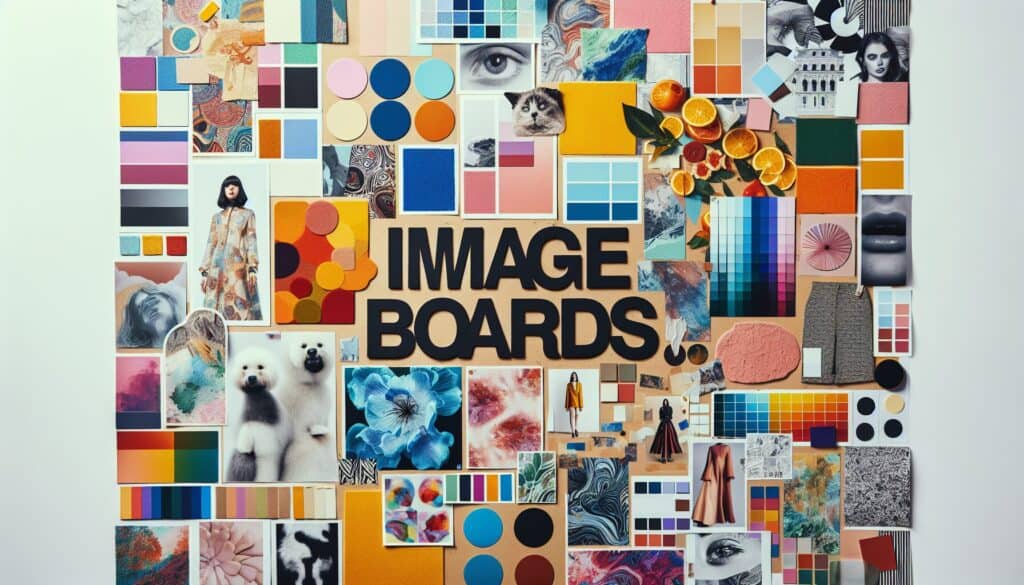Die gewünschte Ästhetik, den Stil, den emotionalen Ton und die allgemeine Richtung für ein kreatives Projekt oder Produkt visuell zu erkunden und zu vermitteln.
- Methodologien: Kunden & Marketing, Wirtschaft, Produktdesign
Bildtafeln (Mood Boards)

Bildtafeln (Mood Boards)
- Markenstrategien, Kreative Design-Strategien, Design Denken, Human-Centered Design, Ideenfindung, Prototyping, Benutzererfahrung (UX), Benutzeroberfläche (UI), Visuelle Gestaltung
Zielsetzung:
Wie es verwendet wird:
- Eine Collage aus Bildern, Texturen, Farben, Typografie und anderen visuellen Elementen, die zusammen das beabsichtigte Erscheinungsbild darstellen. Wird als Inspirations- und Kommunikationsinstrument innerhalb eines Designteams und mit Interessengruppen verwendet.
Vorteile
- Erleichtert die kreative Erkundung und Ideenfindung, hilft bei der frühzeitigen Festlegung einer klaren visuellen Identität, verbessert die Kommunikation und die Ausrichtung auf ästhetische Ziele und kann neue Designrichtungen inspirieren.
Nachteile
- Kann fehlinterpretiert werden, wenn es nicht gut kuratiert oder erklärt wird, kann zu übermäßig abgeleiteten Designs führen, wenn die Tafeln zu restriktiv sind, die Erstellung kann zeitaufwändig sein, die Effektivität hängt von der Qualität und Relevanz des gewählten Bildmaterials ab.
Kategorien:
- Kunden & Marketing, Ideenfindung, Produktdesign
Am besten geeignet für:
- Die frühen Phasen von Designprojekten (Grafikdesign, Innenarchitektur, Mode, Produktdesign, Branding), um die visuelle und emotionale Richtung zu definieren und zu kommunizieren.
Image boards, commonly known as mood boards, play a significant role in bridging the gap between abstract concepts and tangible design in various industries. They are frequently employed during the ideation phase of projects in sectors such as graphic design, interior design, fashion, and product development, where visual aesthetics are paramount. In practice, team members from different disciplines, including designers, marketers, and engineers, collaboratively gather inspiration—ranging from color palettes to materials and typography—to establish a shared vision that aligns with the project’s goals and user expectations. For instance, in product design, a mood board may integrate textures and visual materials that reflect the desired user experience, informing the tactile qualities of the final product. The iterative nature of mood boards allows participants to experiment with styles and elements without significant investment in resources, encouraging creativity and innovation. By providing a concrete reference point, they facilitate discussions around aesthetic choices, ensuring that stakeholders remain aligned on the project’s visual narrative and emotional resonance. This collaborative tool not only enhances the initial creative phase but can also serve as a benchmark for evaluating design decisions throughout the project lifecycle, ensuring that the resultant design remains consistent with the established visual identity. As such, these boards are valuable in scenarios where initial ideas need to be communicated effectively to clients, investors, or team members, ensuring that everyone involved has a unified understanding of the creative direction.
Die wichtigsten Schritte dieser Methodik
- Identify core themes and concepts relevant to the project.
- Gather visual elements such as images, textures, and colors that resonate with those themes.
- Curate and arrange selected visuals into a cohesive layout.
- Refine the arrangement to enhance communication of the desired emotional and visual direction.
- Present the mood board to stakeholders for feedback and alignment on aesthetic goals.
- Iterate on the mood board based on received feedback to ensure relevance and clarity.
- Use the finalized mood board as a guide throughout the design process.
Profi-Tipps
- Incorporate user-generated content or existing design artifacts to ensure authenticity and relevance to user needs.
- Utilize a digital platform for collaborative mood board creation, allowing real-time feedback and iterative development from varied team members.
- Create multiple iterations of mood boards throughout the design process to adapt and reflect evolving project goals and stakeholder input.
Verschiedene Methoden lesen und vergleichen, Wir empfehlen die
> Umfassendes Methoden-Repository <
zusammen mit den über 400 anderen Methoden.
Ihre Kommentare zu dieser Methodik oder zusätzliche Informationen sind willkommen auf der Kommentarbereich unten ↓ , sowie alle ingenieursbezogenen Ideen oder Links.
Historischer Kontext
1986
(wenn das Datum nicht bekannt oder nicht relevant ist, z. B. "Strömungsmechanik", wird eine gerundete Schätzung des bemerkenswerten Erscheinens angegeben)

Verwandte Artikel
Fragebögen zu muskuloskelettalen Beschwerden
Multivariate Tests (MVT)
Mehrfache Regressionsanalyse
Motion-Capture-Systeme
MoSCoW-Methode
Moods Median-Test